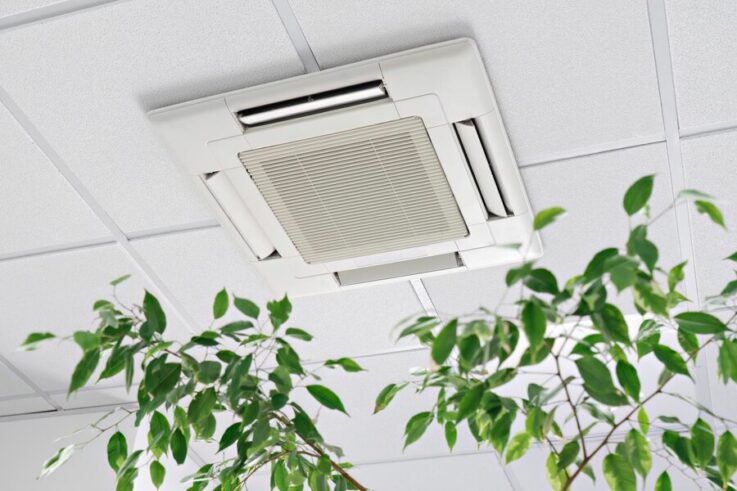
Improving Indoor Air Quality for Healthier Home Environment
Improving Indoor Air Quality for Healthier Home Environment
Air quality is a fundamental aspect of our living environment, yet it’s often overlooked. From pollutants generated by cooking and cleaning to those seeping in from outdoors, the air inside our homes can harbor a myriad of contaminants. This neglect can have profound effects on our health, triggering allergies, exacerbating respiratory conditions, and even impacting cognitive function. In this blog post, we’ll delve into the importance of improving indoor air quality and explore practical strategies to create a healthier sanctuary for ourselves and our loved ones.
Understanding Indoor Air Quality
Indoor air quality (IAQ) refers to the condition of the air within buildings, particularly homes, concerning the presence of pollutants and other harmful substances. These contaminants can include dust, pet dander, mold spores, volatile organic compounds (VOCs) from cleaning products and furnishings, tobacco smoke, and more.
Poor IAQ can lead to various health issues, including allergies, asthma, respiratory infections, headaches, fatigue, and even long-term lung damage. Monitoring and improving IAQ is crucial for maintaining a healthy indoor environment and reducing the risk of adverse health effects for occupants.
The Hidden Dangers Within Our Homes
Despite the comfort and security our homes provide, they can also harbor hidden dangers in the form of indoor air pollutants. Many common household activities, such as cooking, cleaning, and using certain products, can release harmful substances into the air. Additionally, poor ventilation and inadequate airflow can exacerbate the buildup of indoor pollutants.
These contaminants can have serious health implications, particularly for vulnerable individuals such as children, the elderly, and those with pre-existing respiratory conditions. Recognizing and addressing these hidden dangers is essential for creating a safe and healthy living environment for ourselves and our families.
Impact of Poor Air Quality on Health
Poor indoor air quality can have a profound impact on our health, leading to a range of adverse effects. Exposure to indoor pollutants such as dust, mold, pet dander, and VOCs can trigger allergic reactions, exacerbate respiratory conditions like asthma and bronchitis, and increase the risk of developing respiratory infections.
Long-term exposure to indoor air pollution has also been linked to more serious health problems, including cardiovascular disease, lung cancer, and neurological disorders. By improving indoor air quality through effective ventilation, filtration, and pollutant reduction strategies, we can mitigate these health risks and create a safer and healthier environment for ourselves and our families.
Allergies: A Sign of Indoor Pollution
Allergies are often a telltale sign of poor indoor air quality and indoor pollution. Dust mites, pet dander, mold spores, and other allergens can accumulate indoors, triggering allergic reactions in susceptible individuals. Symptoms of indoor allergies may include sneezing, coughing, congestion, itchy eyes, and skin rashes. Additionally, exposure to indoor pollutants can exacerbate existing allergies and respiratory conditions, making symptoms more severe and difficult to manage.
Recognizing the connection between allergies and indoor pollution is the first step towards improving indoor air quality and creating a healthier living environment. Implementing measures to reduce indoor allergens, such as regular cleaning, proper ventilation, and using air purifiers, can help alleviate symptoms and improve overall indoor air quality.
Respiratory Health: The Silent Victim
While the effects of poor air quality on respiratory health are well-documented, they often lurk unnoticed, earning respiratory health the title of the silent victim. Indoor pollutants like dust, pollen, mold, and smoke can irritate the respiratory system, leading to symptoms such as coughing, wheezing, shortness of breath, and chest tightness.
Prolonged exposure to these pollutants can worsen respiratory conditions like asthma and chronic obstructive pulmonary disease (COPD), increasing the risk of respiratory infections and even lung damage. Prioritizing clean indoor air through proper ventilation, air filtration, and pollutant reduction is essential for safeguarding respiratory health and preventing silent harm.
Cognitive Function: How Air Quality Affects Our Minds
The quality of the air we breathe doesn’t just impact our physical health; it also influences our cognitive function and mental well-being. Poor indoor air quality, characterized by high levels of pollutants like volatile organic compounds (VOCs) and particulate matter, has been linked to cognitive impairments such as reduced concentration, impaired memory, and diminished decision-making abilities.
These effects are particularly pronounced in environments with inadequate ventilation, where indoor pollutants can accumulate to harmful levels. By prioritizing good indoor air quality, we can create environments that support optimal cognitive function, enhancing productivity, focus, and overall mental clarity.
Identifying Common Indoor Air Pollutants
Understanding the common indoor air pollutants is crucial for maintaining a healthy indoor environment. Some of the most prevalent pollutants include:
- Particulate Matter: Tiny particles suspended in the air, originating from sources like dust, pollen, and smoke.
- Volatile Organic Compounds (VOCs): Chemicals emitted from products such as paints, cleaning agents, and furniture.
- Carbon Monoxide (CO): A colorless, odorless gas produced by incomplete combustion, commonly from gas appliances.
- Formaldehyde: Found in building materials, furniture, and certain household products, emitting as a gas over time.
- Radon: A radioactive gas seeping into homes from soil and rock beneath the foundation.
Sources of Indoor Air Pollution
Indoor air pollution can stem from various sources within our homes, including:
- Cooking: Smoke and fumes generated during cooking can introduce pollutants like particulate matter and carbon monoxide.
- Cleaning Products: Many household cleaners contain chemicals that release VOCs, contributing to indoor air pollution.
- Tobacco Smoke: Smoking indoors releases harmful chemicals and particulate matter into the air, impacting both smokers and nonsmokers.
- Building Materials: Volatile compounds like formaldehyde can off-gas from building materials, carpets, and furniture.
- Mold and Moisture: Dampness and mold growth can release spores and mycotoxins, leading to indoor air quality issues.
Practical Tips for Improving Air Quality
Enhancing indoor air quality doesn’t have to be daunting. Here are some practical tips to get you started:
- Keep it Clean: Regularly dusting, vacuuming, and mopping can help reduce the accumulation of dust, pet dander, and other allergens.
- Ventilation: Proper ventilation is essential for circulating fresh outdoor air indoors and expelling indoor pollutants. Open windows and use exhaust fans, especially during activities like cooking and showering.
- Go Green: Incorporate houseplants like spider plants, peace lilies, and snake plants to naturally filter indoor air and add a touch of greenery to your space.
- Filter It Out: Use high-efficiency air filters in your HVAC system to capture airborne particles and improve indoor air quality.
- Banish Tobacco: Implement a strict no-smoking policy indoors to prevent tobacco smoke from contaminating the air.
Ventilation: The Key to Fresher Air
Ventilation plays a pivotal role in maintaining indoor air quality by exchanging stale indoor air with fresh outdoor air. Proper ventilation not only removes indoor pollutants but also helps regulate humidity levels and prevent the buildup of harmful gasses like carbon monoxide. To maximize ventilation, consider:
- Opening windows and doors regularly to allow for natural airflow.
- Using exhaust fans in kitchens, bathrooms, and other high-moisture areas to expel pollutants and excess humidity.
- Installing trickle vents or mechanical ventilation systems to ensure consistent air exchange, especially in tightly sealed homes.
- Utilizing cross-ventilation techniques by opening windows on opposite sides of your home to promote airflow.
Air Purifiers: Your Allies in Clean Air
Air purifiers are indispensable tools for improving indoor air quality, effectively removing airborne pollutants such as dust, pollen, pet dander, and smoke. These devices work by drawing in air and passing it through filters that trap and neutralize contaminants, releasing cleaner air back into the environment.
With a variety of options available, including HEPA filters and activated carbon filters, air purifiers can cater to different indoor air quality needs. By investing in an air purifier, you can enlist a powerful ally in your quest for cleaner, fresher air and a healthier home environment.
Natural Remedies for Cleaner Indoor Air
In addition to technological solutions like air purifiers, incorporating natural remedies can further enhance indoor air quality. Houseplants are nature’s air purifiers, absorbing carbon dioxide and releasing oxygen while also filtering out harmful airborne pollutants. Plants like spider plants, peace lilies, and Boston ferns are particularly effective at removing common indoor toxins.
Moreover, essential oils with antimicrobial properties, such as tea tree oil and eucalyptus oil, can be diffused into the air to combat bacteria and mold. By harnessing the power of nature, you can create a cleaner, healthier indoor environment for you and your loved ones.
Creating a Healthy Home Environment
A healthy home environment is essential for promoting overall well-being and vitality. Start by maintaining clean indoor spaces through regular dusting, vacuuming, and airing out. Minimize sources of indoor pollution by choosing eco-friendly cleaning products and avoiding smoking indoors.
Ensure proper ventilation to circulate fresh air and expel indoor pollutants. Incorporate natural elements like houseplants and essential oils to improve indoor air quality naturally. Finally, prioritize comfort and safety by regulating temperature and humidity levels and addressing any structural issues promptly. By implementing these practices, you can create a healthy home environment that nurtures both your physical and emotional health.
Prioritizing the improvement of indoor air quality is not just about creating a comfortable living space—it’s about safeguarding the health and well-being of you and your loved ones. With simple yet effective strategies like proper ventilation, air purification, and natural remedies, you can transform your home into a sanctuary of clean, fresh air.
At Cool Factory, Inc., located in Sterling, VA, we’re dedicated to helping you achieve a healthier home environment. Contact us today at (703) 713-5113 to learn more about our air quality solutions and take the first step towards breathing easier and living better.






